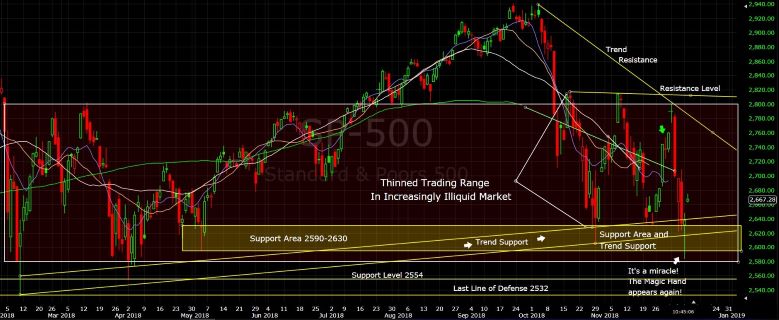The market-reversing "Magic Hand" appeared again Monday, just when it looked as though all was lost. Is this the bottom?
One thing is certain: There is a crucial support area from 2,590 to 2,630 on the S&P 500 (see the chart below). On Monday it was stretched beyond the limit, when suddenly, out of nowhere came the Magic Hand.
In this instance, the bulls can thank the shorts again, because with liquidity tight and getting tighter, there's not enough intrinsic demand for stocks to mount a massive, lasting rally. But in a market that has become thin because prices have crossed the same range over and over, short covering can drive a fast rally – but only until the short covering exhausts itself. And those times are getting shorter.
Nevertheless, when the earth is in its final hours, with the core about to explode and obliterate the last remaining vestiges of life, there is one thing that you can count on.
The shorts will cover.
I remember the old saw of the ancient, white-haired, wise-men traders I sat with in customers' galleries at Walston & Company back in the late 1960s and early 1970s, when bear markets were the rule: "He who sells what isn't his'n, must buy it back or go to prison."
And short sellers have hair triggers. Once they see that support isn't breaking down, they pile in all at once to cover their positions. That also tends to pull in a few long-side buyers who have cash. They're in short supply now, however.
Ultimately, each of these short-covering rallies weakens the market because they deplete the demand that is coming from short covering. So, what about short interest today? Will it continue to drive rallies every time support is threatened?
Examining Primary Dealer and customer shorts gives us some obvious answers...
Look at What Just Happened
But first, let's look at what happened on Monday. The market plunged and threatened to break important support around 2,590–2,600. In fact, it did momentarily in the middle of the day. Then the Magic Hand appeared and stocks reversed. Once it was clear that the support break had whipsawed – roughly about the time the S&P rose back above 2,600 – the buying, most likely by shorts anxious to protect profits, really kicked in.

That led to panic buying in the futures overnight. That caused a big gap open in New York. Normally, I'd look for a move to a 50% retracement of the sell-off that started last week. That would take the S&P 500 Index (SPX) to around 2,690, which would be in the middle of the recent range.
I would not buy more puts on the SPDR S&P 500 ETF (NYSE Arca: SPY) there just yet. I like to think of trading in mid range as being akin to a piece of beef in a meat grinder; I would not put my hand in. If the S&P hangs around that 2,690 area, it will probably make a run at the big downtrend line now in the 2,780s. If it rolls over around or below 2,690, then the rout may be on. I would definitely want a stop at 2,700 though, just in case the meat grinder gets turned on.
There Are Shorts, and Then There Are Shorts
Now what about the short interest? Looking at the Primary Dealer Shorts versus their customers, the trends are ominous. The dealers are shorting relatively more, and the customers – the bulk of whom are big institutions and hedge funds – are shorting relatively less. Guess who is usually right?
You Must Act Now: America is headed for an economic disaster bigger than anything since the Great Depression. If you lost out when the markets crashed in 2008, then you are going to want to see this special presentation…
Customers were skeptical of the bull thesis in early 2016, as they increased their shorting early in that rally. They continued to increase their shorts after Trump was elected, until January 2017. They then became believers in the bull case, and their short covering from April 2017 on helped fuel the final stages of the bubble.

This is weekly data, issued with a lag of nine days. It is of no use for short-term timing. But the point here on this chart is obvious. The institutional customers of the Primary Dealers still believed in the bull thesis right through Nov. 28. Their bullishness can be measured by the drop in their short positions to the lowest level of the two years on this chart, and even including 2015 (not shown), when their short positions were even higher.
In the recent air pockets in the market in October and November, they reduced their shorts even more. This means that there will be even less potential short covering to fuel future rallies.
[mmpazkzone name="in-story" network="9794" site="307044" id="137008" type="4"]
The dealers, meanwhile, behaved similarly early in 2016, disbelieving the rally and shorting more. Early in 2017, the dealers abruptly started covering. They kept their shorts minimal from May 2017 until April 2018. They liked the rally, and missed the first sell-off in February.
Here's where it gets really interesting. While their customers continued to reduce their shorts, the dealers started to increase theirs, particularly during the bubble blowoff from April to September this year. Their spokesmen showed up on CNBC regularly to tell you to buy, buy, buy, but their trading desks were shorting stock to their customers.

It gets even more interesting. We can plot the ratio of customer to dealer shorts to make a kind of long-term sentiment indication. Look what happened this year. The ratio has been collapsing all year because dealers were shorting more, and hedge funds and institutions less.

So who's the smart money? In Vegas, is it the "house" dealers, or the players at the tables? Wall Street is no different. The Primary Dealers are the house, and institutional investors and hedge funds are the whales. Yes, they're whales, but it's the dealers' job to take their money while being very nice to them just the same, or even more so.
The House Is Getting Shorter – Here's How to Play on Their Side
The house is trending shorter and shorter relative to the players. I want to play the game on the side of the house. It's their business to take the customer's money. And lately they've been doing more of it by increasing their shorts as they take the other side of their customers' trades.
For our purposes, I think the best way to do that is to buy puts on the SPY when the market approaches resistance, which now looks to be around 2,690–2,700. I would, under current conditions, also be willing to buy puts on a breakdown below 2,580.
In either case, I like the nearest in-the-money SPY puts with about four weeks to expiration. I would keep a mental stop at just above the resistance level on the SPY or SPX, either 2,700 or 2,600, depending on the entry. Again, I'd take half the position off when the SPX reaches the next support level – in this case, about 2,533.
New AI Helps Deliver Recommendations with the Power to Double Your Money Daily
It eliminates the lag associated with most technical analysis.
It can make you extra cash whether the markets are up or down, with strictly limited risk.
It generates daily plays with the potential to double like clockwork.
And it can put you in position to secure $3,000, $4,000, even $5,000 a day – right off your phone or computer – from anywhere in the world.
Learn how this new AI works right here.
The post The Magic Hand Appears Again But These Charts Show It Will Cut The Cord appeared first on Lee Adler's Sure Money.
About the Author
Financial Analyst, 50-year charting expert, finance + real estate pro, and market analyst; published and edited the Wall Street Examiner since 2000.



